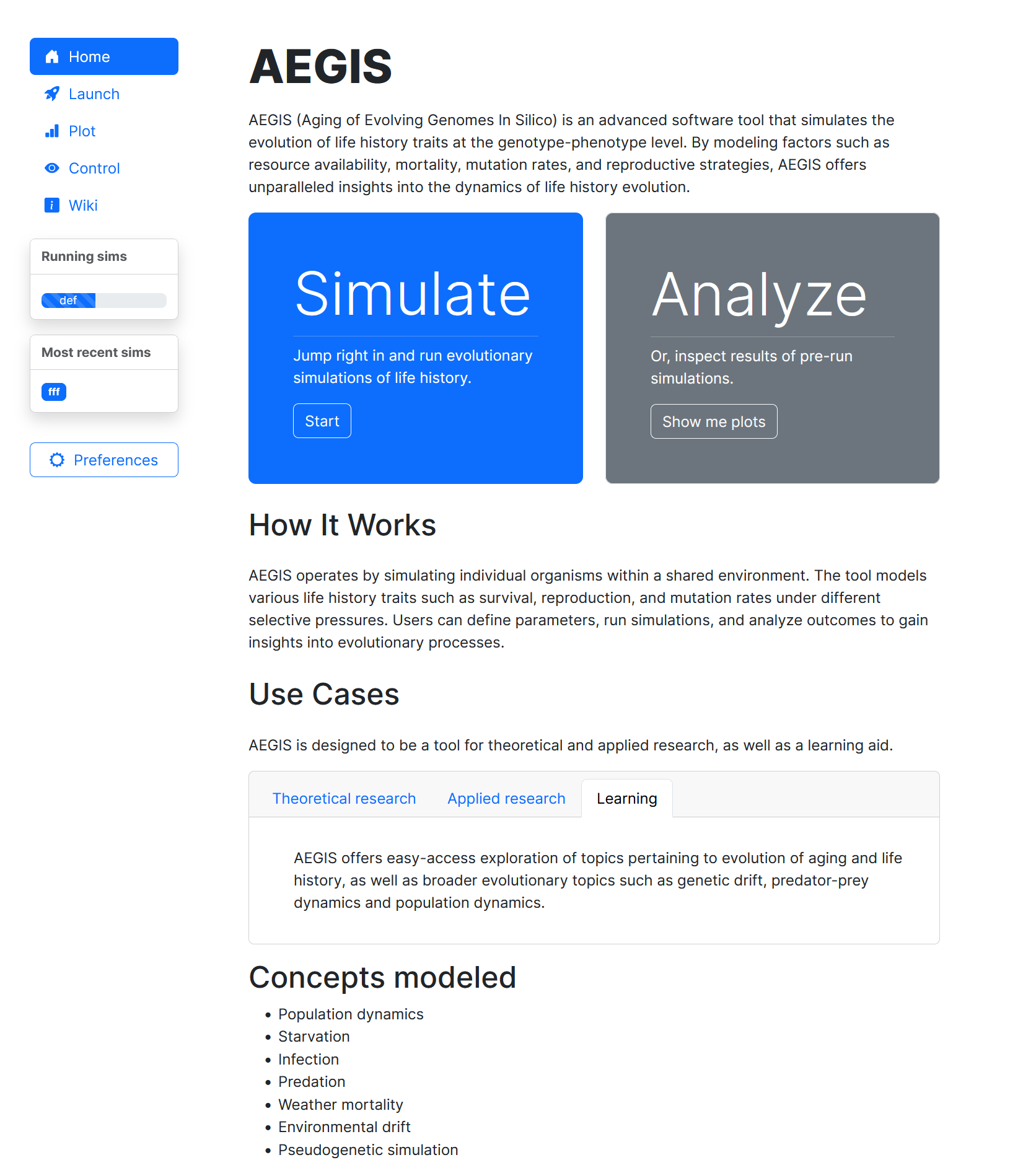Numerical model for life history evolution of age-structured populations
Project description
AEGIS
Aging of Evolving Genomes In Silico (AY-jis, /eɪd͡ʒɪs/)
Numerical model for life history evolution of age-structured populations under customizable ecological scenarios.
How to use
You can run AEGIS simulations on a webserver or locally. The webserver is especially useful if you want to try AEGIS out and run a couple of simple simulations. For more demanding simulations, it is best to install and run AEGIS on your local machine.
Webserver use
You can access the AEGIS webserver here. The server is running AEGIS GUI.
Local use
You can install AEGIS locally using pip (pip install aegis-sim). The package is available on https://pypi.org/project/aegis-sim/. You can use AEGIS with a GUI or in a terminal. GUI is useful for running individual simulations, while the terminal is useful for running batches of simulations.
aegis gui # starts GUI
aegis sim -c {path/to/config_file} # runs a simulation within a terminal
aegis --help # shows help documentation
To run simulations within a terminal, you need to prepare config files in YAML format which contain custom values for simulation parameters. The list of parameters, including their descriptions and default values you can find here. An example of a config file:
RANDOM_SEED: 42
STEPS_PER_SIMULATION: 10000
AGE_LIMIT: 50
Developer installation
If you want to contribute to the codebase, install AEGIS from github:
python3 -m pip install -e git+https://github.com/valenzano-lab/aegis.git#egg=aegis-sim
If you are having installation issues, check that pip is up to date (python3 -m pip install --upgrade pip).
AEGIS GUI
Graphical user interface for AEGIS can be used on the webserver or with a local installation. It contains sections for launching and analyzing/plotting simulations.

Documentation
Model description
Most documentation about the model is available within the GUI itself, including description of inputs, outputs, submodels and the genetic architecture. Use the webserver or a local installation to access the GUI. Further information is available in the following articles:
- AEGIS: An In Silico Tool to model Genome Evolution in Age-Structured Populations (2019)
- An In Silico Model to Simulate the Evolution of Biological Aging (2016)
API reference
Exhaustive, searchable API reference made by pdoc is available here.
Contributors
Project details
Download files
Download the file for your platform. If you're not sure which to choose, learn more about installing packages.
Source Distribution
File details
Details for the file aegis-sim-2.3.0.1.tar.gz.
File metadata
- Download URL: aegis-sim-2.3.0.1.tar.gz
- Upload date:
- Size: 1.0 MB
- Tags: Source
- Uploaded using Trusted Publishing? No
- Uploaded via: twine/5.1.1 CPython/3.8.10
File hashes
| Algorithm | Hash digest | |
|---|---|---|
| SHA256 | 3324bd98fe299108d1aac21535a07f177d716689409d46f76e78cd3d48d3f444 |
|
| MD5 | 3b0c8ad2713d0b480e6b7bc6707101e4 |
|
| BLAKE2b-256 | b4f8a0b885953f7a0ffd5f4d7ab7024c9429fa6542721d2e070fb8a48b551a0f |














